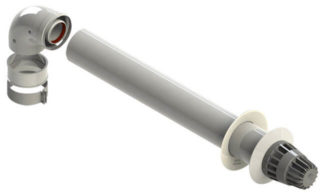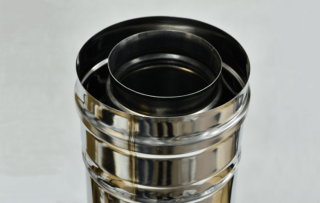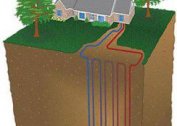Heating a house with a boiler requires two main requirements - a continuous supply of air to support the combustion process and the removal of combustion products. Today, the most effective, easy-to-use type of chimney is a coaxial pipe for a gas boiler. It is characterized by high efficiency and safe operation.
What is a coaxial chimney
The structure of the chimney is such that inside the pipe with a longer length is a second short one. There is also a condensate collector. The set includes a set of knees, clamps, pads.
The purpose of the thin inner pipe is to discharge combustion products. The material of its manufacture is high-quality stainless steel. The role of the outer pipe is to supply street air to the internal combustion chamber. From the side of the room, the pipes are connected to the boiler, and their opposite ends extend outside the room. Since the outer pipe does not have direct contact with hot gas and aggressive chemicals, cheap material can be used for its manufacture.
This kind of chimney is used in boilers that support open burning of fuel. Where a traditional stovepipe cannot be used for various reasons, coaxial is installed. For safety reasons, gas boilers are not recommended to be connected to old stove channels.
For example, this option is used in apartments with individual heating. The boiler can be installed on the first floors, while the pipe is mounted in a horizontal position, and the traction is provided by an integrated turbine.
Production material
In the manufacture of coaxial chimney, two types of material are used - stainless steel and plastic
Plastic
The main advantage of the plastic system is its affordable price. PVC pipes are lightweight, which greatly facilitates their installation. However, the service life of such a product will be lower than that of a pipe made of high-quality stainless steel. The optimal solution would be to use a combined material - an inner pipe made of stainless steel and an outer one made of PVC.
Stainless steel
The plus of the stainless steel pipeline is the high heat resistance of the material. Stainless steel is much better than plastic withstands the effects of high temperatures and condensate with an aggressive chemical composition. If the system uses food grade stainless steel, you can be sure of the durability of the pipe.
To reduce the amount of condensate and its rapid evaporation from the inner surface, the structure is insulated or a finished product with a heater is purchased.
Types of coaxial systems
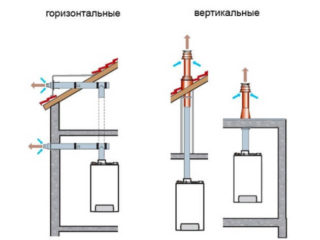 The method of discharge of combustion products depends on the type of boiler and the layout of the room in which it is installed. There are two ways to remove the coaxial chimney outside the room: horizontal - through the wall, vertical - through the ceilings and the roof structure of a private house. If the boiler is located on the ground floor, the lateral installation method will be more convenient.
The method of discharge of combustion products depends on the type of boiler and the layout of the room in which it is installed. There are two ways to remove the coaxial chimney outside the room: horizontal - through the wall, vertical - through the ceilings and the roof structure of a private house. If the boiler is located on the ground floor, the lateral installation method will be more convenient.
Vertical
This type of chimney is used exclusively for private housing construction. The tube passes through the ceilings, the roof and is led upstairs. In terms of ecology, this option for the removal of combustion products is more environmentally friendly. In addition, this method provides natural traction.
In the lower part of the pipe, a plastic or metal condensate receiver must be installed.The vertical installation of a chimney for a boiler with a closed combustion chamber is more expensive and time-consuming.
Horizontal
Horizontal installation method is the only available option for an apartment. This method requires a minimum consumption of materials. Negative pipe slope provides natural condensate removal.
Installation Rules
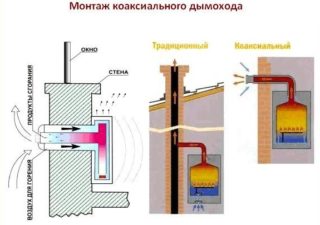 Horizontal installation is easier than vertical. Installation can be done independently. Such a chimney will take up quite a bit of space. There are several rules that are recommended to be observed during self-installation:
Horizontal installation is easier than vertical. Installation can be done independently. Such a chimney will take up quite a bit of space. There are several rules that are recommended to be observed during self-installation:
- Outside, the distance between the ground and the pipe should be at least 2 meters.
- The free distance from the chimney to other elements located in the room should be at least 50 cm.
- The distance from the bottom of the window to the vent located below should be greater than 100 cm.
- On the outside, from the ground to the pipe, there must be a free space of at least 150 cm high, not occupied by a fence, poles or adjacent walls.
- In order for the condensate to drain directly to the ground, the chimney is mounted with a slope of 3 - 12 degrees.
- It is not allowed to bring the pipe into an adjacent room. Only to the street.
- The distance between adjacent pipes should be at least 20 cm.
For independent manufacture and installation of a coaxial chimney, you will need to purchase:
- pipes of the required diameter;
- adapters for connecting pipes to the boiler;
- tees and knee.
Reliable fixation of parts is performed using crimp clamps. When buying a chimney, the kit comes with all the necessary elements for assembling and fixing the structure.
Insulating fire-resistant gaskets are used in the places where the pipe passes through the structures of the house - in ceilings, roofs and walls. They protect materials that come into contact with a heated chimney from overheating and fire.
Advantages and disadvantages of coaxial chimneys
When comparing a coaxial chimney with other varieties, its advantages are obvious:
- For clean air to enter a closed chamber, a closed system is used. Therefore, air from the room where the boiler is installed is not consumed.
- When using such a scheme, the probability of penetration of dangerous carbon monoxide into the room is eliminated.
- The system does not affect the formation of draft in the room, changes in humidity, temperature, as well as other microclimate parameters.
- With such a chimney, the gas boiler acquires increased productivity. At the same time, natural gas is consumed in an economical mode, and the amount of harmful substances in the environment is reduced.
- The chimney does not come into contact with adjacent structures and materials due to the presence of a protective casing and an air layer.
If, during installation and during operation of such a system, the manufacturer's recommendations are followed, there is no probability of emergency situations. Another nice plus is the affordable cost of such a chimney.
The only drawback of the coaxial pipe is the freezing of condensate in cold weather on the pipe section located outside. This issue can easily be solved by additional insulation with mineral or basalt wool. Some models are equipped with a special head. Specialists do not recommend shortening the pipe.
